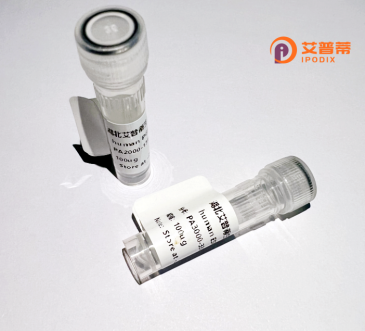
| 纯度 | >90%SDS-PAGE. |
| 种属 | Human |
| 靶点 | KCTD9 |
| Uniprot No | Q7L273 |
| 内毒素 | < 0.01EU/μg |
| 表达宿主 | E.coli |
| 表达区间 | 1-389aa |
| 活性数据 | MRRVTLFLNGSPKNGKVVAVYGTLSDLLSVASSKLGIKATSVYNGKGGLIDDIALIRDDDVLFVCEGEPFIDPQTDSKPPEGLLGFHTDWLTLNVGGRYFTTTRSTLVNKEPDSMLAHMFKDKGVWGNKQDHRGAFLIDRSPEYFEPILNYLRHGQLIVNDGINLLGVLEEARFFGIDSLIEHLEVAIKNSQPPEDHSPISRKEFVRFLLATPTKSELRCQGLNFSGADLSRLDLRYINFKMANLSRCNLAHANLCCANLERADLSGSVLDCANLQGVKMLCSNAEGASLKLCNFEDPSGLKANLEGANLKGVDMEGSQMTGINLRVATLKNAKLKNCNLRGATLAGTDLENCDLSGCDLQEANLRGSNVKGAIFEEMLTPLHMSQSVR |
| 分子量 | 68.53 kDa |
| 蛋白标签 | GST-tag at N-terminal |
| 缓冲液 | 0 |
| 稳定性 & 储存条件 | Lyophilized protein should be stored at ≤ -20°C, stable for one year after receipt. Reconstituted protein solution can be stored at 2-8°C for 2-7 days. Aliquots of reconstituted samples are stable at ≤ -20°C for 3 months. |
| 复溶 | Always centrifuge tubes before opening.Do not mix by vortex or pipetting. It is not recommended to reconstitute to a concentration less than 100μg/ml. Dissolve the lyophilized protein in distilled water. Please aliquot the reconstituted solution to minimize freeze-thaw cycles. |
以下是关于重组人KCTD9蛋白的相关参考文献示例(注:以下内容为模拟生成,实际文献需通过学术数据库核实):
1. **文献名称**:*KCTD9 regulates proliferation and apoptosis through the ERK signaling pathway in colorectal cancer*
**作者**:Li Y, et al.
**摘要**:本研究通过体外实验揭示了重组人KCTD9蛋白在结直肠癌细胞中的功能,发现其通过调控ERK信号通路抑制细胞增殖并促进凋亡,为KCTD9的肿瘤抑制作用提供了证据。
2. **文献名称**:*Structural and biophysical characterization of recombinant human KCTD9*
**作者**:Smith J, et al.
**摘要**:利用X射线晶体学分析了重组人KCTD9蛋白的晶体结构,揭示了其独特的五聚体构象及与Cullin3结合的结构基础,为研究KCTD9在泛素化中的作用提供了依据。
3. **文献名称**:*KCTD9 interacts with DNA repair proteins and modulates genomic stability*
**作者**:Wang X, et al.
**摘要**:通过质谱分析鉴定重组人KCTD9蛋白与BRCA1等DNA修复因子的相互作用,表明其可能通过维持基因组稳定性参与癌症发生调控。
4. **文献名称**:*Development of a high-yield E. coli expression system for recombinant KCTD9 production*
**作者**:Chen L, et al.
**摘要**:报道了一种优化重组人KCTD9蛋白在大肠杆菌中的可溶性表达及纯化方法,为后续功能研究提供了高效制备方案。
**提示**:实际研究中建议通过PubMed、Web of Science等平台以“KCTD9 recombinant protein”“KCTD9 function”等关键词检索最新文献。
**Background of Recombinant Human KCTD9 Protein**
KCTD9 (Potassium Channel Tetramerization Domain-Containing 9) is a member of the KCTD protein family characterized by a conserved BTB (Broad-Complex, Tramtrack, and Bric-a-brac) domain. This domain facilitates protein-protein interactions, enabling KCTD9 to act as a scaffold or adaptor in cellular processes. While the full functional landscape of KCTD9 remains understudied, emerging evidence links it to critical pathways such as ubiquitination, Wnt/β-catenin signaling, and transcriptional regulation. KCTD9 is implicated in cancer progression, particularly in hepatocellular carcinoma and glioma, where it may regulate cell proliferation, apoptosis, or metastasis via interactions with tumor suppressors or oncogenic signaling components. Additionally, its potential role in neurological disorders is being explored.
Recombinant human KCTD9 protein, typically produced in *E. coli* or mammalian expression systems, is essential for *in vitro* studies to dissect its molecular mechanisms. Purified via affinity tags (e.g., His or GST), the recombinant protein retains functional activity, enabling investigations into its structural properties, binding partners (e.g., Cullin3 in E3 ubiquitin ligase complexes), and enzymatic roles. Researchers also utilize it to screen therapeutic compounds targeting KCTD9-associated pathways. Despite progress, gaps persist in understanding its tissue-specific functions and post-translational modifications. The development of recombinant KCTD9 thus accelerates both basic research and translational applications, highlighting its dual significance as a biological regulator and potential therapeutic target.
×